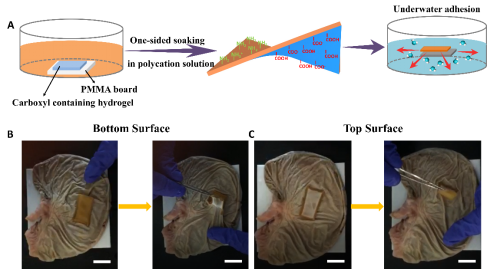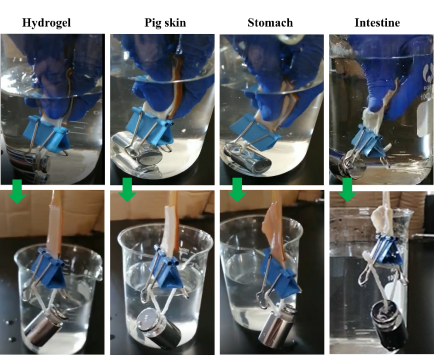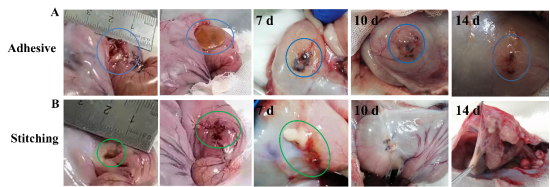当体内组织或器官受到较大的创伤时,需要对组织创伤部位进行缝合,而使用手术缝合线可能对组织造成二次伤害加重病人的痛苦,也会造成组织间的黏连。因此,寻求容易操作、无需清除的生物可降解组织黏合剂以替代传统的手术缝合线成为当务之急。但是,目前已经被报道的组织黏合剂均表现为两面黏附,除了里侧黏附受损组织外,外侧也会黏附其他组织,造成组织黏连,严重影响其对于内脏器官的修复。
近日,5822yh银河国际网页版刘文广教授团队设计了一种“两面神”黏附水凝胶,该凝胶的两面表现出了截然相反的黏附特性,一面可以牢固地黏附在体内的受损组织以替代手术缝合线,另一面不具黏合性,可以有效防止组织间发生黏连。通过使用寡聚糖对侧链含有羧基的水凝胶进行单面浸泡,寡聚糖与凝胶内部的羧基发生梯度复合从而形成了一种在湿态下可快速实现对组织黏附的“两面神”水凝胶(图1)。

Figure 1. A: Schematic illustration of the formation of Janus hydrogel by gradient polyelectrolyte complexation via dipping one-side of carboxyl-containing self-adhesive hydrogel in polycation solution, as well as its application for underwater adhesion; B: the adhesion property of bottom surface of the Janus hydrogel to stomach; C: the adhesion property of top surface of the Janus hydrogel to stomach. (Scale bar: 1.5 cm)
含羧基的凝胶与寡聚糖直接接触的一面,因羧基几乎全部被复合而失去黏附性,而远离寡聚糖溶液的一面,则因在最外表面保留了自由羧基而具有黏附性,并且由于羧基和氨基的静电复合导致的相分离还赋予了该面疏水和排水的能力,因此,这一侧表面对生物软组织均显示出了优异的湿态黏附效果(图2)。

Figure 2. Underwater instant adhesion of the Janus hydrogel to PAAm hydrogel, pig skin, stomach and intestine; all the adhered substrates can lift a weight of 100 g.
将该“两面神”黏附水凝胶用于动物体内胃穿孔的修复,黏附面可以牢固地黏接在胃穿孔部位,促进了穿孔部位的组织修复,而不粘面则起到了防止组织间黏连的作用,并且该凝胶在体内14天内完全降解。而使用手术缝合线对胃穿孔部位进行修复后,则表现出了明显的组织黏连(图3)。

Figure 3. Janus hydrogel for gastric perforation repair. A rabbit stomach perforation model was created by piercing the stomach with scissors (stomach perforation diameter is about 0.5cm) and rabbit’s gastric perforation was repaired with the Janus hydrogel (A) (the bottom surface of the Janus hydrogel was adhered to the perforation site of the rabbit stomach, and the top surface of the Janus hydrogel was gently pressed for 30 s) and surgical suture (B) with a comparison of the healing effect at day 7, 10 and 14 after surgery (the blue and green circles are the gastric perforation sites of the rabbit’s stomach).
目前上述工作已发表在《Advanced Functional Materials》上,论文第一作者为5822yh银河国际网页版5822yh银河国际网页版博士生崔春燕,通讯作者为5822yh银河国际网页版5822yh银河国际网页版刘文广教授。论文连接:https://onlinelibrary.wiley.com/doi/10.1002/adfm.202005689